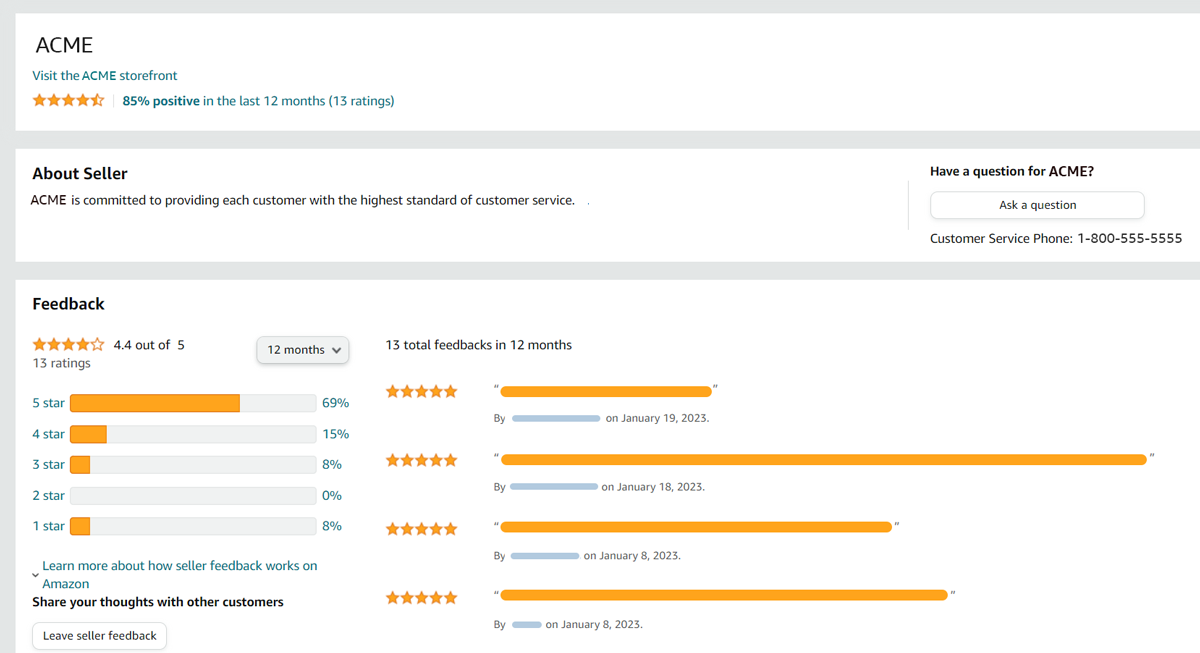Originally published on June 9, 2015, updated May 18, 2023
Menu
Join Our Email List
- Receive our monthly newsletter.
- Stay up to date on Amazon policies.
- Get tips to grow your business.
Amazon and eBay are two of the world’s leading eCommerce companies, and Amazon holds the top spot worldwide in terms of revenue. Each has its own offerings to attract different types of merchants looking to sell new and pre-owned items online.
An integral part of both marketplaces is feedback, which enables customers to describe their satisfaction with buyers. The two websites are different, however, in terms of the type of feedback system they employ to establish trust between these two parties.
The importance of seller reputation is greater today than it was several years ago. Buyers might pay attention to a seller's feedback and reviews as well as their pictures or product descriptions, but we know that both eCommerce platforms themselves care a great deal about a seller’s feedback.
Because user comments greatly impact product buyability (not to mention a seller's account health), Amazon’s and eBay’s feedback systems have undergone changes to keep up with the demand for intuitive user interfaces. But at the same time, each marketplace has established and retained its own distinctive feedback culture.
In a nutshell, the main difference between the two online marketplaces is that Amazon focuses on seller feedback, while eBay’s feedback system allows both buyers and sellers to comment on their trading partners.
Here’s a closer look at the feedback systems of Amazon vs. eBay.
eBay features the Feedback Profile, an online “reputation” that develops gradually based on other users’ comments and ratings. It has four aspects:
Feedback Profiles are searchable by member ID. eBay’s feedback system is most likely accurate when it comes to seller profiles, but the buyer profile model might need some work.

That might be why Amazon sticks with one type of feedback over another. In fact, since 2008, eBay sellers can only rate buyers with a positive rating and a short comment. Reportedly, sellers used to post retaliatory negative feedback for buyers and the scores became skewed.
Seller feedback is a vital indicator of an Amazon merchant’s performance, especially when it includes negative feedback as a percentage of the total. It gives potential buyers a holistic view of a seller’s business.
An Amazon seller's profile also includes the Feedback Score, which shows the rating for the past 12 months, percentages, and feedback counts. Another component of Amazon’s system is current feedback, which shows actual feedback and additional ratings from buyers.

Seller feedback follows a 5-star system:
Feedback percentages are rounded off to the nearest whole number.
Amazon’s counterpart of eBay’s Detailed Seller Ratings is the Seller Performance Measurement. The metrics include Order Defect Rate (ODR) where a high percentage of negative feedback will have a huge impact on seller performance.
On Amazon, the site itself often sends a reminder within 2 days of the maximum estimated delivery date. Amazon also encourages sellers to request feedback, resolve issues, and systematically improve the customer experience. Many sellers use feedback solicitation tools like FeedbackFive to manage this aspect of their business.
A seller can respond to a negative comment through the platform. This, however, does not guarantee that the negative feedback will be removed by the buyer.

An appropriate response can be useful, nonetheless, since the response can be noticed by other buyers and by Amazon, in the event your account is under review. Feedback can only be removed, not edited.
On eBay, it's a little simpler: the buyer leaves a comment after receiving the item. The seller then leaves feedback for the buyer. Feedback is a permanent part of sellers’ records. Buyers are encouraged to reach out to sellers to sort out issues with them before leaving negative feedback. Buyers also have the opportunity to revise their feedback.
First up is Amazon, where buyer feedback is not removed except for those that include:
If a buyer leaves inaccurate feedback, the seller can reach out to the buyer to resolve any issues with the transaction and request deletion. Only professional emails are allowed. Pressing the buyer to remove the negative feedback may land the seller in hot water since it is a violation of Amazon’s policies.
Learn More: Amazon Feedback Removal Guidelines: What You Need to Know
Meanwhile, eBay does allow sellers to request a revision of buyer feedback. The buyer could either agree to revise the feedback or decline the request.
After a review process, sellers with poor performances on Amazon are given up to 60 days to improve. Sellers with very poor performances are immediately removed without any “probationary” period. Sellers can also be suspended for policy violations.
On eBay, suspension of accounts can only be caused by non-payment of fees or a violation of a rule or policy.
Amazon sellers with good feedback performances are eligible for the Buy Box. Sellers with this status earn placement advantages. The ODR customer feedback is one of the criteria considered by Amazon.
Along with selling a significant volume of items and offering a high-level service, having a positive feedback score on eBay could qualify a seller for the Top Rated Seller program. Benefits include credit for certain listing upgrade fees and promotional offers.
Feedback policies for Amazon vs. eBay may be different, but both sites offer a beneficial culture of communication. Without a solid feedback system, an online marketplace would not gain the safety and trust of its users.
Originally published on June 9, 2015, updated May 18, 2023
This post is accurate as of the date of publication. Some features and information may have changed due to product updates or Amazon policy changes.
These Stories on Feedback and Reviews
14321 Winter Breeze Drive
Suite 121 Midlothian, VA 23113
Call us: 800-757-6840





Copyright© 2007-2025 eComEngine, LLC. All Rights Reserved. eComEngine®, FeedbackFive®, RestockPro®, and SellerPulse® are trademarks or registered trademarks of eComEngine, LLC. Amazon's trademark is used under license from Amazon.com, Inc. or its affiliates.
Comments (1)